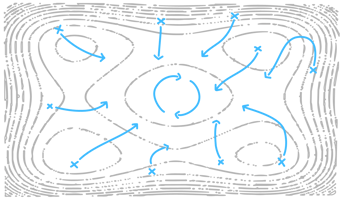Basic management functions provide a starting point for organization design aiming to empower self-directed teams and to increase decentralized decision-making in organizations.
When you want to move beyond managerial hierarchy and empower self-directed work in your organization, there is still management work that must be done. While some of the work managers currently do might be discarded as unnecessary, self-serving bureaucracy that doesn’t need to be replaced, other management work will have to be reallocated within the new organizational structure.
As a result, you need to look at the basic functions of management, or the role of a manager in principle. The basic functions of management allow you to analyze which activities, deliverables, and decisions are involved in the work of your managers, and to determine which levels of decentralization make sense for your organization. In turn, this analysis will allow you to design your organization accordingly.
What are the basic management functions that need to be fulfilled in any organization?
When we speak of basic management functions, we don’t mean the functional differentiation of roles that contribute to an organization’s value chain, such as human resource management (HRM), the roles of operations management, the roles of a finance manager, or the roles of marketing management and production management.
We also don’t mean the classical list of four to five functions of management (often presented in reference to Henry Fayol), which describes management as comprising planning, organizing, commanding (or leading), and controlling - a list of elements that Henry Mintzberg famously debunked (in his classic HBR article “The Manager’s Job”) as a wholly inadequate description of actual management practice, which is much more fragmented, ad-hoc, and discontinuous than this neat terminology would suggest.
Rather than focusing on the role of the manager, we focus on the management functions that an organizational system requires in order to work (regardless of which roles fulfill them or how they are fulfilled). The six basic management functions that must be provided for, one way or the other, are:
-
Leading the definition of purpose, strategy, and goals
-
Defining the organizational structure, processes, and design
-
Allocating resources and staffing
-
Managing people, pay, and rewards
-
Controlling task execution
-
Executing work and providing outputs
Note that these six basic management functions could be mapped to the classic list of four mentioned above (planning, organizing, commanding/leading, and controlling). However, if you detach the functional view from its taken-for-granted nexus with the manager role, the perspective changes. For example, there must be an allocation of resources and staffing - but the functional view invites you to create novel ways of fulfilling that function, without designating it to a single boss role within the chain of command.
Designing organizational structures to enable self-managed teams
In organizations that move towards self-management, new organizational designs must be found that ensure that the respective management tasks are covered in a reliable way across different levels of management, no matter what level of authority is granted to individual roles. This includes alignment and integration across roles or units, as required.
To that end, the Management Functions Matrix allows you to analyze management activities, deliverables, and decisions along those six functional areas and determine the level of authority granted to self-directed teams.



